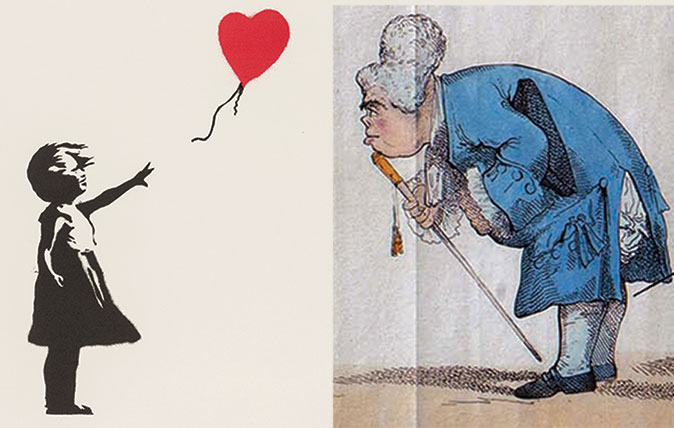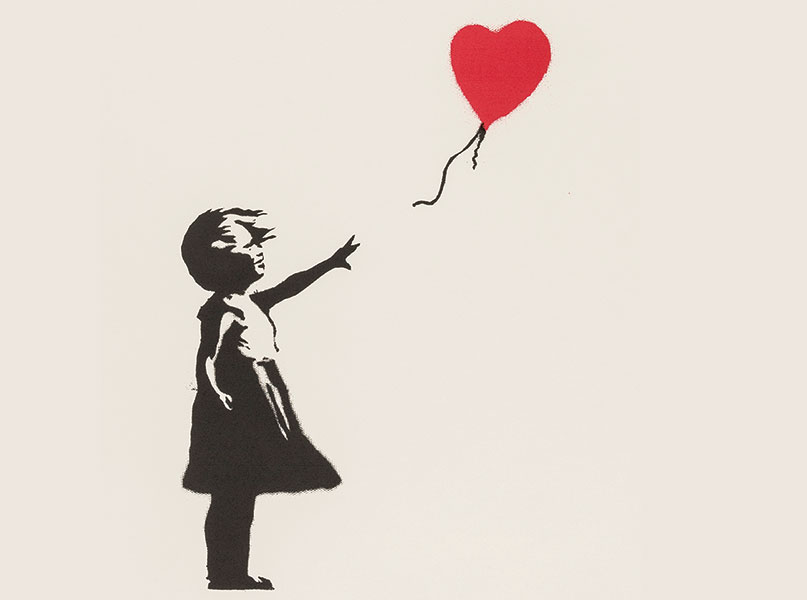An 18th century Byronic Banksy for sale at the same time as the 21st century equivalent
Art has been used for social commentary for millennia, but it's always fascinating to see how differently it's handled across eras. Two pieces of work up for auction in the next few weeks encapsulate different approaches.


The Prince’s Bow is a print from an engraving created in 1788 by Frederick George Byron, cousin of the poet, and takes aim at the great and good of British society. It refers to the trial of Warren Hastings before Parliament opened on February 10 of that year.
Hastings had been impeached for corruption in his capacity as Governor-General of Bengal and first Governor of British India and Westminster Hall was packed for the beginning of the proceedings, which were to drag on for seven years and end in an acquittal.
The Prince of Wales, then the comparatively slim Prinny rather than the gross figure he became as Regent and George IV, took his place among the peers and attracted great comment for the elegance of his bow to the throne, which represented his father.
The print is representative of a type that was very fashionable at the turn of the 19th century, which can be seen as one of the ancestors of the comic strip. Henry William Bunbury, Thomas Rowlandson and George Dance were among the amateur or professional artists who produced them, sometimes, as here, offering a series of variants of a theme, and sometimes a story on the lines of The Progress of a Lie.

Frederick Byron was born in Mansfield in 1764, visited France at the beginning of the Revolution and died at Hotwells, Bristol, in 1792, having gone there to take the waters in hopes of a cure. His drawing is not often of this standard and, as the print is said to have been ‘designed’ rather than drawn or etched by him, he may have had help, perhaps from Bunbury, or it may have been etched from his drawing by a more professional hand.
Some of the 19 figures attempting to bow like the Prince seem to be generic types, but others are easily identifiable and it is possible that more would have been recognisable to their first audience.
Among them are dandies, macaronis, leftovers from the 1760s, Scots, a Frenchman, an officer of the Irish Volunteers (perhaps Lord Altamont), a bishop, a Jew possibly intended as one of the Prince’s moneylenders, Lord Chancellor Thurlow, the eccentric George Hanger, Edmund Burke, Charles James Fox and, just possibly, William Pitt the younger.
Sign up for the Country Life Newsletter
Exquisite houses, the beauty of Nature, and how to get the most from your life, straight to your inbox.
The print was published by William Holland and originally offered for sale at 7s 6d uncoloured or 13s 6d coloured. It will be on offer at the Chester Antiques Show between October 12 and 15, priced at £7,000 with W. R. Harvey of Witney, Oxfordshire.
At the more modern end of this scale is a screenprint one of Banksy's most famous works Girl With Balloon, from an edition of 600 such prints.

How much it makes remains to be seen, though the estimate is £28,000-£32,000. A similar print from an earlier edition of 150 sold for £69,000 last October, but in July a Banksy sold for £6,786 which captured a moment from art history – specifically auctioneer Charles Hindlip's 15 minutes of Warholian fame from 1987 when, at Christie’s, he sold a version of van Gogh’s Sunflowers for £22 million.
A much more expensive Banksy came up over the summer as well: Nola, a 29¾in by 21¾in screenprint of a girl under an umbrella where it rains (an idea taken straight from Dalí) which originally appeared on a wall in New Orleans following Hurricane Katrina. It made £62,400. Not bad for a street-art derivative.
Country Life is unlike any other magazine: the only glossy weekly on the newsstand and the only magazine that has been guest-edited by HRH The King not once, but twice. It is a celebration of modern rural life and all its diverse joys and pleasures — that was first published in Queen Victoria's Diamond Jubilee year. Our eclectic mixture of witty and informative content — from the most up-to-date property news and commentary and a coveted glimpse inside some of the UK's best houses and gardens, to gardening, the arts and interior design, written by experts in their field — still cannot be found in print or online, anywhere else.
-
 About time: The fastest and slowest moving housing markets revealed
About time: The fastest and slowest moving housing markets revealedNew research by Zoopla has shown where it's easy to sell and where it will take quite a while to find a buyer.
By Annabel Dixon
-
 Betty is the first dog to scale all of Scotland’s hundreds of mountains and hills
Betty is the first dog to scale all of Scotland’s hundreds of mountains and hillsFewer than 100 people have ever completed Betty's ‘full house’ of Scottish summits — and she was fuelled by more than 800 hard boiled eggs.
By Annunciata Elwes